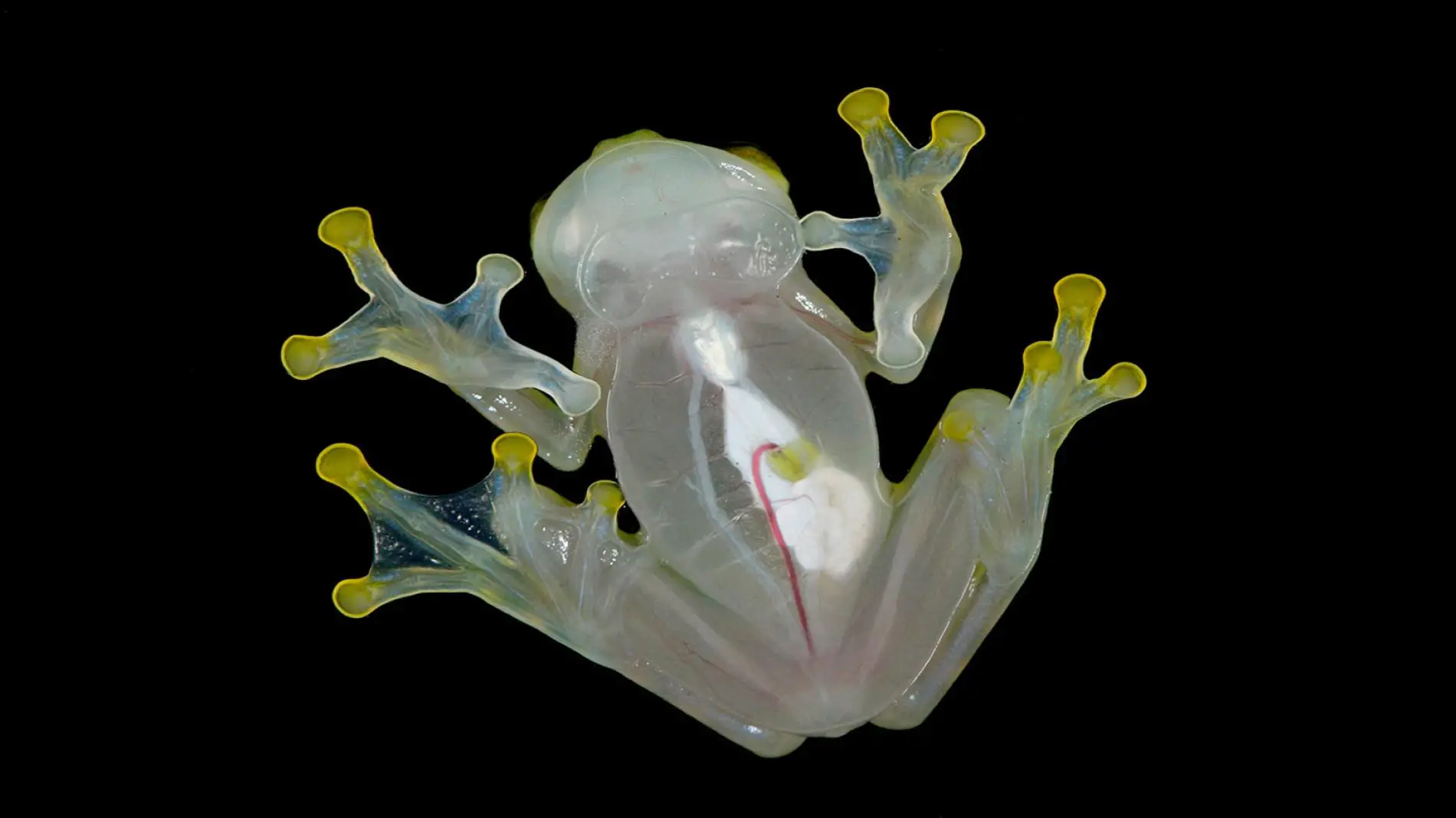Scientific Facts
| Common Name: | Glass Frog |
| Scientific Name: | Centrolenidae |
| Life Span: | 10-14 years in the wild |
| Size: | Smaller species: 0.78 inches long Larger species: 3 inches |
| Habitat: | Tropical rainforests, usually in high treetops above the water |
| Country of Origin: | Central and South America including Belize, Costa Rica, Colombia, Guatemala, Honduras, Mexico, and Panama |
Physical Description
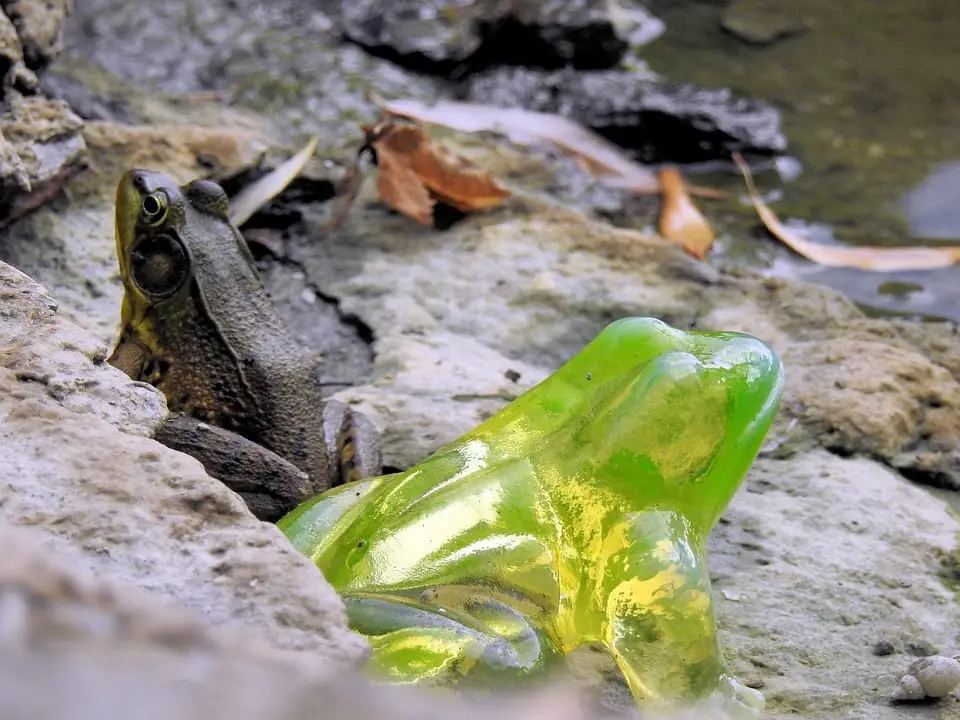
These are frog species that are generally smaller and will only range from 3-7.5 cm (1.2-3.0in) long. One of their main indicators is that their bodies have a green color, and the bottom part can be transparent. They are normally associated with the frogs of the Eleutherodactylus family and to tree frogs because of their physical appearance. Glass frogs are also known to have their eyes facing forward.
Types
There are a lot of Glass frog species, and more and more people are discovering new ones as the day goes by.
1) Hyalinobatrachium
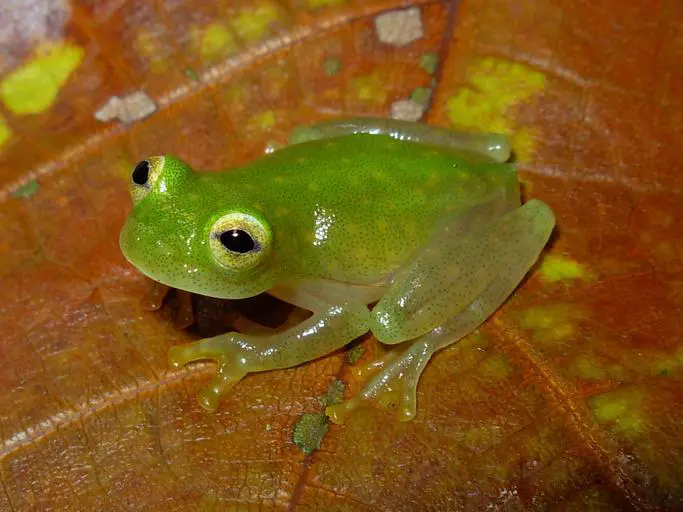
These can be found in the Americas ranging from tropical Mexico to Southeastern Brazil and Argentina. Their bulbous liver is covered by white color, and the adult males lack a humeral spine. Their bones are colored white, and males can be seen calling from the bottom part of the leaves. While the females often deposit a layer of eggs underneath the leaves.
2) Centrolene
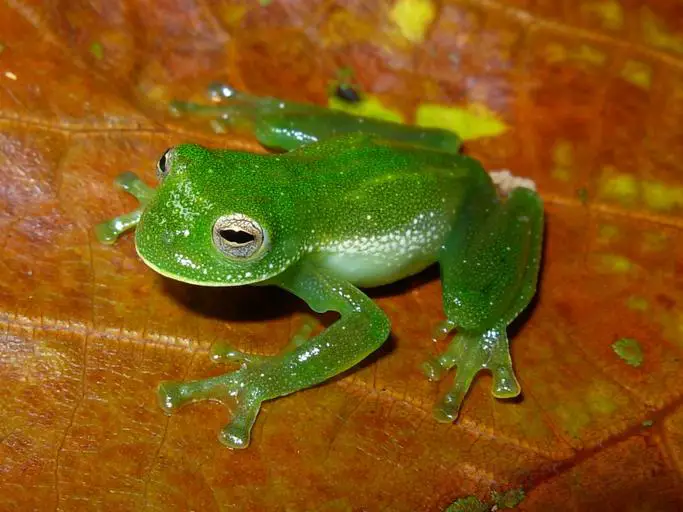
The adult males of the Centrolene Glass Frogs have a humeral spine that can be seen in the other members of their family. They are tagged as the giants in the Glass Frog species, but this is just in relation to the sizes they have in comparison to the other species.
3) Cochranella
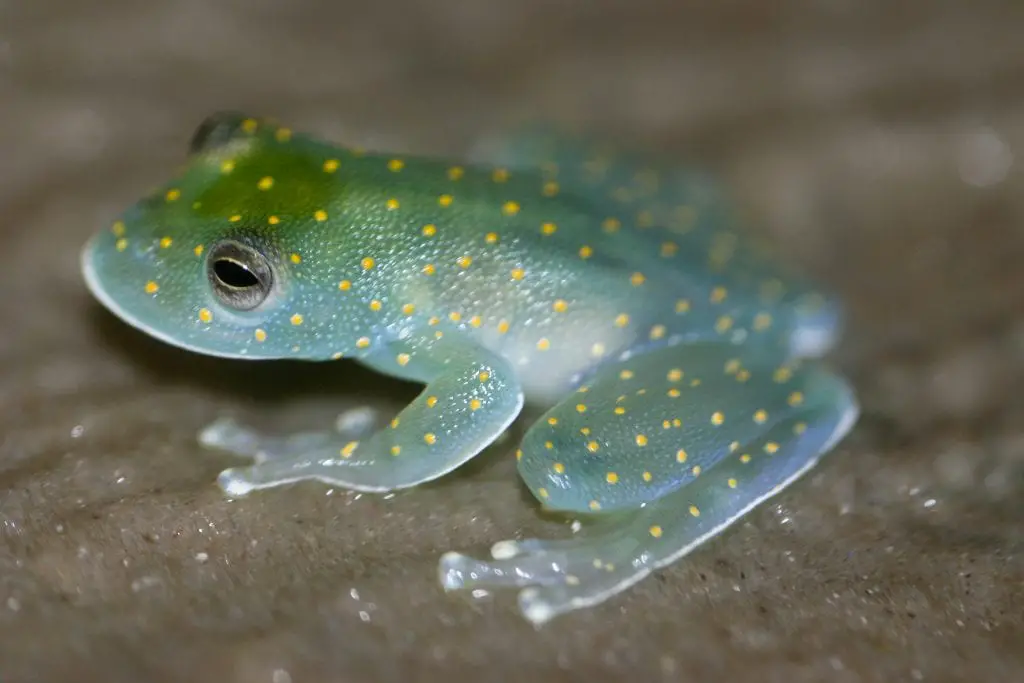
Cochranella can be found in Central America, and they can be located in Honduras to the Amazon and Andean forests located in Colombia, Ecuador, Bolivia, and Peru. Their distinguishing characteristic is that the humeral spines are not present. Their digestive tract is white, their livers are lobed, and their bones are green.
4) Sachatamia ilex

This can be found in eastern Nicaragua. Panama, western Colombia and Ecuador, and Costa Rica. They are color green, and their toes are webbed. The male ones will call females from the upper surfaces of the leaves. The color of their eggs is black, and they are often deposited on the upper part of the leaves.
5) Hyalinobatrachium valerioi
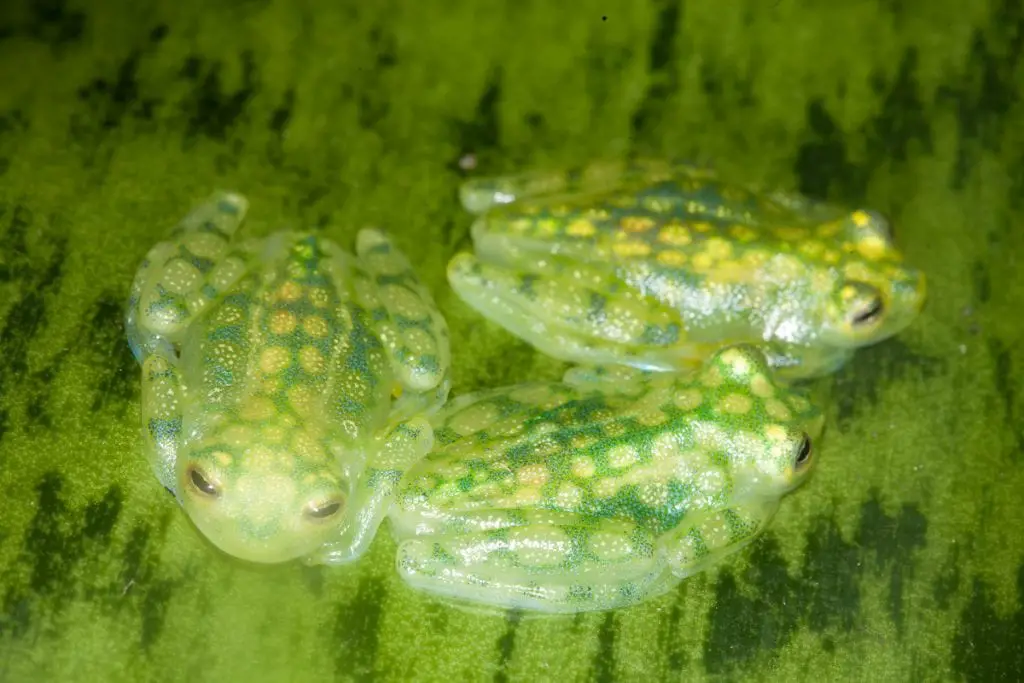
Also called the La Palma Glass Frog and they are often located in Central Costa Rica, south Panama, and western Colombia and Ecuador. These may have small dark spots in the green areas in their bodies. The upper part of their bodies is transparent, and their hearts are covered by white tissue and can’t be seen. Their eyes are gold while the liver and the whole digestive tract is white.
6) Hyalinobatrachium fleischmanni

This is called the Northern Glass Frog or Fleischmann’s Glass Frog, and they are often located in the tropical regions of the United States. They may look like tree frogs, but their main distinguishing factor is that they have golden eyes that point forward.
They are seen to camouflage under the leaves, and they are seen staying above the water during day time. Their color is green yet semi-translucent. Their skin offers camouflage by having dots that match the leaves.
7) Espadarana prosoblepon
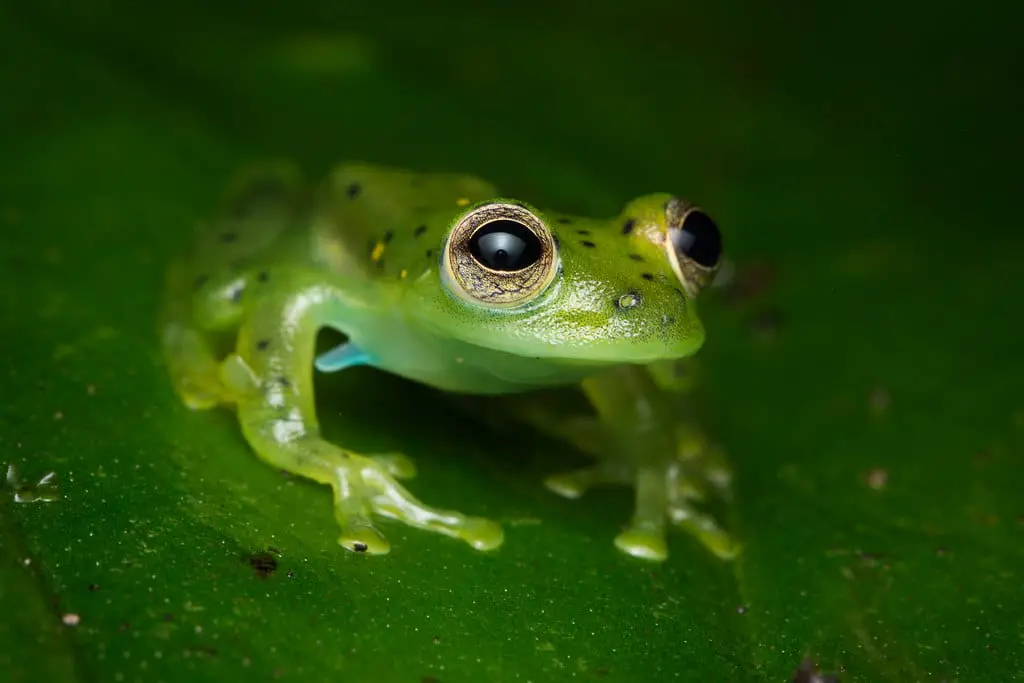
Also called as the Emerald Glass Frog or the Nicaragua Giant Glass Frog. It can be located in a variety of areas that includes Panama, Costa Rica, Honduras, Nicaragua, and Ecuador. They are often found in lowland tropical forests and cloud forests. They are small and of the green color, and they may have dark spots on their backs. Their translucent bodies are used for camouflage, and their humeral hooks are used for fighting. Both males and females have a green color.
Eating Habits
Glass Frogs are believed to primarily eat tiny insects. The Pacific Giant Glass Frog can feed on larger prey such as fishes and other species of frogs. Their feeding schedule typically varies depending on the conditions of their natural habitat. They can be seen being active during nighttime, but there are also Glass Frog species who can be active and feeding during rain showers during day time.
Development and Reproduction
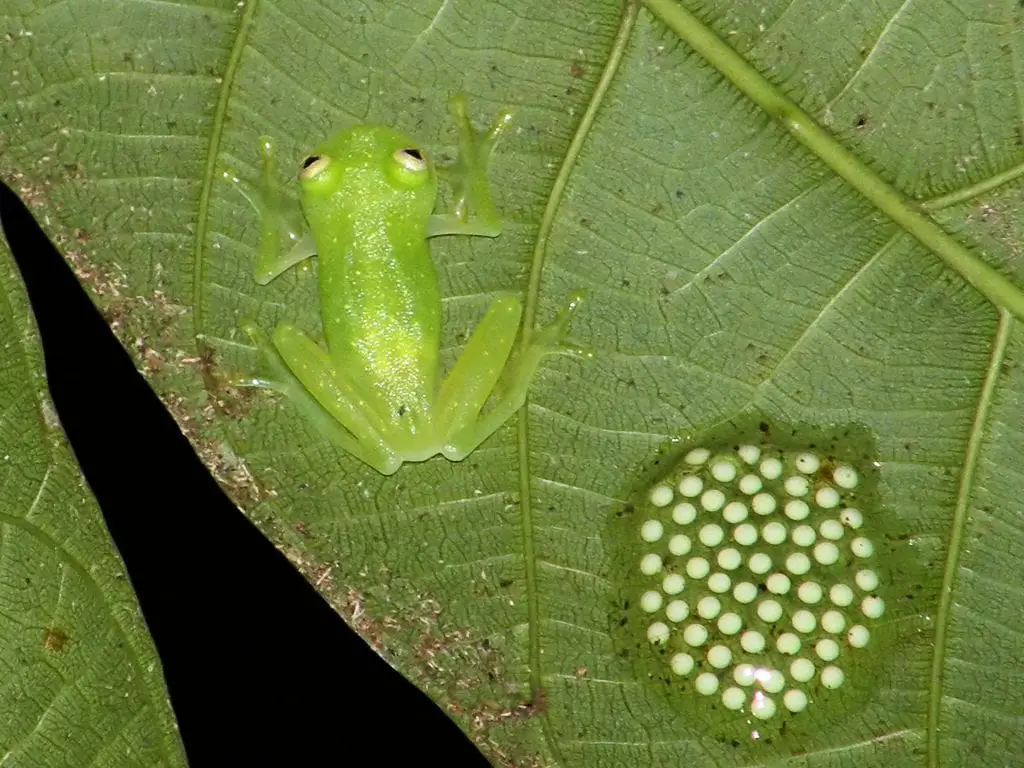
The Glass Frogs that dwell in regions with basically the same weather for the whole year round have the tendency to mate on any night they prefer. However, for those who reside in areas wherein the weather is constantly changing, they will only mate for a certain period of time.
Male Glass frogs are known to be extremely picky about their mating and breeding area. The male will have to find a good spot, and he might have to fight with other male Glass Frogs to have his own territory. Two males may be seen fighting over a leaf or a stem, and their back feet are seen hanging upside down while they wrestle one another.
The winner of this amazing fight between Glass Frog is the one who managed to scramble on the leaf’s surface and has to flatten it to his own body. After establishing his territory, he will call the female for a mating session. They may have different calls, but these may sound like whistling. They can also call the female 43 times in an hour.
Most of them can be seen calling from leaves or trees located above streams, and they will usually dot his at night. Some of them will prefer spots located in the streams while others will be behind waterfalls or boulders near bodies of water.
The female who heeds the call of the male Glass Frog will approach him, and he will climb onto her back. This position is also called amplexus, and their mating session will continue with the male wrapping his front legs around the female, and he will hang onto her. The male Glass Frog will also stay there until the female begins laying her eggs. As she lays her eggs, the male will then release its sperm that will only result in the eggs starting to develop.
Their eggs can often be deposited in leaves of shrubs or trees that hang over a body of water. There was a species of the Glass frog that has been observed to leave the eggs in stones that are in close proximity to waterfalls.
Their egg-laying method varies among different species, but most of the males can be seen calling from the leaves where their egg clutches are located. The eggs that have been laid in leaves are also at lower chances of getting eaten by predators in comparison to those who are completely laid in the water. A disadvantage of laying eggs in leaves is that they might be infested by parasitic maggots.
This is one of the reasons why the Glass Frogs have parental care towards the eggs. They are also seen brooding their eggs during the night that they have become fertilized, and this helps in increasing the survival rate of the eggs.
Some Glass Frog species also stay on guard for a much longer period of time. As the eggs hatch, the tadpoles will naturally fall into the water located below the leaves. The tadpoles have long bodies with tails and fins that are powerful enough to suit the flowing water. If it’s not yet their breeding season, some Glass Frogs can be seen living in canopies.
How to Breed
Breeding captive Glass frogs will always be dependent on the natural conditions of their tanks and the species themselves. If your Glass frog is healthy and housed in an enclosure that has a lot of plants with a good moving water source, you may encourage them to breed by increasing the humidity levels. Having an automated rain-chamber device can help you with this; otherwise, you can use heavy spraying in their tanks.
The automated rain chamber will refer to any type of device that can help in stimulating rain showers in the enclosures. Males will then feel ready for breeding if they can be seen calling the female and if their tanks mimic the condition like those of a rainy season.
Provide your female a good amount of healthy food so that it will be easier for her to develop healthy eggs. These eggs will develop after successful amplexus with their chosen males. Unlike in the wild, captive Glass Frogs will deposit their eggs on glass or the surfaces of their enclosure. The number of eggs will be dependent on how healthy the species are; the usual number will be around 20-30 eggs.
If your pet Glass frog is already in the breeding season, you need to monitor their enclosure on a daily basis and confirm if there are egg masses that might have been deposited from the night before. If you notice that there are indeed egg masses that have been deposited, you can either leave them there, and they will undergo their development in the tank.
You can also put them in a separate incubation container. This can be a small, clean, plastic box where you can put the eggs along with any substrate. You can help increase the humidity by putting a small cup with clean, warm water. Spray the eggs lightly every couple of days to ensure that they don’t dry out.
You may also place a plastic film with small holes over the top to ensure that the moisture is locked in. You need to observe the eggs closely to confirm that there is no fungal infection taking place. Once an egg has gone bad, you can just simply remove it from the batch. The total number of days needed for its development will depend on the temperature and on the type of Glass Frog involved. The usual number of days is between 7-15 days.
After hatching, you may place them in their rearing containers. They are known to have an extended larval stage that it might even take them a year to undergo metamorphosis completely. The typical larval stage can last up to 7-10 months.
You can use the floor substrate from their incubation container and place them in their earing container. You have to check that no toxic items or pollutants are in the substrate. The rearing containers should be placed in an area that receives a good amount of lighting, but this should not be beyond 27 degrees Celsius (80 degrees Fahrenheit).
Once you notice that the water in the container turns green, this means that there is already microalgae present in it, and the larvae can be placed in it already. You should carefully monitor their development, and you may even document to ensure that everything is smooth sailing.
The penetration of the front limbs will often mean that the larvae have reached the metamorphosis stage. An intermediate container will be required during this stage, and this should contain 50% terrestrial, and the other 50% should be for the aquatic environments. You can place a gradual slope in this container so that the Glass Frog will not have a hard time exiting when they are ready.
Their transition stage wherein they will absorb the rest of their tail might take several days, and this will make your Glass Frog refuse any food item given to it. After the full absorption of their tails, you should provide them with steady food supply; these can be small food items for their developing bodies.
Giving them appropriately sized food is always recommended. Probably the most challenging and also the most crucial stage in their development is the one after their metamorphosis, it is also during this time that the young ones should be carefully monitored to ensure that they are eating the insects given to them.
Common Health Problems
The most recommended way to make sure that your Glass Frog will not acquire any diseases is by making sure that these are prevented from the initial stages. The following are just some of the common health issues a breeder of Glass frogs may encounter. A golden rule when you notice that your Glass frog ahs become sick is that it should be kept under quarantine to ensure that other pets will not get affected.
1) Nutritional Deficiency
This will occur when your Glass Frogs lack certain vitamins and minerals in their diet. This will manifest in a lot of ways, including being skinny or looking boney. Rickets classified as a deformation disease can also result in poor growth.
Feeding your Glass Frog with only one food type usually causes nutritional deficiency. You have to incorporate different food with sufficient nutritional value to their diet, and you will not have to worry about this disease. You can also use powdered vitamins or minerals and mix it with their food.
Calcium appears to be the most common vitamin deficiency among Glass Frogs, so you can give them calcium-rich food items. You might also notice your Glass Frog being picky when it comes to food; that’s why having a lot of options to choose from will help you in assuring there’s food in their stomachs.
2) Mechanical Wounds
Normally caused by inappropriate handling or when they fight with the other Glass Frogs. You might see this if you happen to place a new specimen in a well-established tank if you suddenly change their environment. These wounds are at high risk of getting a bacterial and fungal infection hence might lead to becoming fatal.
Once you notice that they have wounds on their bodies, separate them from the others, and treat them with an anti-fungal solution. You should consult with a veterinarian before using any type of antibiotics.
3) Red-leg
The well-known disease among captive-bred frogs and this is caused by a parasite called Aeromonas hydrophyla. Initially, it may seem like a simple reddening in the skin, especially around their stomach area and the lower part of their thighs. If you see that your Glass Frog is feeling lazy and lethargic, you need to confirm that it’s not experiencing red-leg.
This is a very lethal disease, and isolating the affected Glass Frog is the only way to go. This can be acquired via simple abrasions that your Glass frog got from cardboard boxes. The only treatment recommended for this is knowing the cause, avoiding it from happening again, and place them in a clean cage for several days.
If it’s still in its initial stage, it can still be treated by giving the Glass Frog a bath using a Sulfamethiazine, and you should do this daily for 2 weeks. The water-solution ratio should be 15ml for every 10L of water. You can bring it to a veterinarian if you notice that there is no improvement in the first week.
4) Fungal Disease
This will normally manifest as an area with red inflammation located on soft white tissue. You can employ the following methods in treating a fungal infection in its early stages: submerge your Glass frog in a 2% solution of malachite green for 5 minutes and do this again after 24 hours if you notice no improvements on the symptoms.
After 3 failed treatments, you can bring it to the veterinarian so that he can give you a prescription of what medicines to use or what to do with fungal infections.
5) Spring Disease
The Spring disease normally occurs during the breeding season and is caused by Bacterium ranicida. This lethal disease will have skin discoloration, yawning, and feeling lethargic as the main symptoms. There is no known treatment for this disease, but experimenting with antibiotics can be recommended.
6) Dropsy
This is more likely a metabolism disorder that might be a result of poor temperature or an unhealthy diet in captive Glass frogs. The Glass Frog may appear bloated with soft dents located in their stomachs. Treatments for this may sound really unusual and risky, wherein it might involve puncturing the wounds; this is only recommended if the wounds are not near the eye region. As a responsible pet owner, the best thing that you can do is bring the Glass Frog to the veterinarian for accurate treatment.
Preventing Illness
The following will serve as checkpoints that you use for ensuring your Glass Frog has good and healthy hygiene.
1) Selecting the frogs
Properly examining the Glass Frog befor3 purchasing them is the best way to start having one as a pet. Always go for the strong and healthy ones, you might see these jumping around often. If you notice that the frog will not have a startled reaction by running when it was grabbed, this may be an indication that it’s not in a healthy condition.
Look out for the obvious signs of malnutrition such as abnormal bone structure, being skinny or they have deformities. Hazy or cloudy eyes are a good sign of infections.
2) Transporting the Frog
You should know as early as now that frogs easily get stressed when they are being transported from one location to another. It’s highly recommended that you transport them as quickly as you can. This should be combined with minimal to zero handlings while transporting.
Becoming freak frogs after transporting them is really not unusual for them. They can be seen hurting themselves by smashing in the wall, or they do crazy things when they experience panic. You need to leave them alone in their new home since this is the time that they may still have heightened panic attacks. Give them ample time to completely adjust to the new environment by not force handling them.
3) Quarantine Period
If you get a new frog, it should be placed under quarantine. However, this will only apply if you already have multiple frogs living in your house. Getting a new frog and placing it on quarantine for quite some time will ensure they are not going to infect other frogs with diseases if they have one.
A simple quarantine may use a separate yet smaller tank and place your new frog in there for about a week before introducing it to others. The quarantine container doesn’t have to be a full-grown tank; this can be a plastic housing that is properly covered. This container can also be used when you are going to transport your frogs.
4) Clean Water
Frogs love spending a lot of time in the water, so having one in their tanks is a requirement that you should not forget. The water should have been dechlorinated before adding them to the tank. You can buy a bottle of dechlorinating solution in any pet store and add drops of it’s in the water.
Regularly cleaning the water, washing your hands before, and cleaning all the tools that you use is essential in keeping the environment sanitized and optimum for their health. Never overfeed your pet frogs as the food debris in the water can cause infection.
5) Ventilation
Too much moisture in their enclosure may lead to possible fungal and bacterial infections, so you have to ensure that their tanks are well-ventilated.
6) Never Overcrowd them
Having a lot of frogs in one enclosure may look good, but this can actually lead to bad situations. For one, this may cause the frog to feel unhappy and stressed out. Second a tank that’s overcrowded also be a breeding ground for both bacteria and fungi.
Third, this can also lead to possible injuries because it’s very easy for them to smack each other or on the walls when they initiate fights. Lastly, some of the species in the tank may be capable of releasing chemicals from their bodies that can be highly toxic to the other ones.
7) Nutrition
Frogs in the wild are known to have a wide array of food options to choose from, and doing this while they are in captivity is not an easy feat. You can have multiple food items ready in your homes; these may include crickets and worms.
8) Handling
Since Glass Frogs are extremely fragile, handling them should be as minimal as possible. Rough handling can also cause a lot of problems to them, such as the salts in your hands will never sit well on their skin. Washing your hands with a mild soap is the most recommended treatment for this.
Some species of frogs may release fluids when they are being handled, this is just a form of their self-defense, but this can be highly toxic. You can use gloves when you handle them and immediately wash your hands right after.
This fluid will come from a reserve supply in their bodies, and this needs to be replaced quickly. Keep in mind that frogs don’t drink water; instead, they absorb it through their skin, so it’s recommended to give your frog an adequate source of water after being handled.
Behavior
The Glass frogs are nocturnal animals, which means they are seen to be usually active at night. Combine their nocturnal behavior with their transparent bodies; it can be very difficult to spot them in the wild. When they are placed under a strong, bright light at night, the Glass Frog appears to have large eyes with a dark smudge that locates its skull.
They also stay out of sight during the daylight since they love hiding among leaves, and there are plenty of leaves in the rainforests and cloud forests. They are normally seen just sitting on the laves and not moving, just casually blending into the environment during the daytime. They also squat their bodies down on the leaves, thus adding to their invisibility while they are in the wild.
Habitat
They are mostly arboreal, and they can be located near rivers and streams during the breeding season. Their population is diverse in the montane cloud forests of both Central and South America. While some of the species have been sighted in the Amazon, semideciduous forests, and the Chocoan rainforest.
Glass Frog in Captive Care
Keeping a glass frog in captive care is easy when you follow these steps.
1) Provide a stable living environment
Remember that your Glass Frog is arboreal in their natural habitat; thus, an enclosure should be more vertical rather than a horizontal one. You need to use plenty of branches and vines to give them the chance to mimic their lifestyle in the wild.
The standard size of their enclosure is 10 gallons (37 liters) per inch (2.5 cm). Others may find this to be a bit too big for a Glass Frog, but since they love exploring around, an enclosure with a big space will definitely result in having a healthy and happy Glass Frog.
2) Use forest floors as a substrate
You have the option to use about 2 inches of soil as the floor of their enclosure. These forest floors are known to hold humidity levels longer, and this might even encourage the development of some insects. The forest flooring in the enclosure can also help in breaking down feces that you have failed to remove. It’s a vital part of the ecosystem in their enclosure.
3) Put plenty of broad leaves
You have a lot of plant options to choose from like bromeliads, pillow moss, or even jungle moss that are usually sold in bricks. Having this in the enclosure will make your Glass Frog feel that it’s in the wild and will eventually feel comfortable living there.
4) Have a large shallow bowl filled with water
You can either use reverse osmosis or distilled water. You may want to create a waterfall or a pool for their tanks. Since Glass Frogs are not really swimmers, they can drown easily on these, so you have to place multiple escapes that are easy to find.
Their water sources should be cleaned on a daily basis or as needed, but keep in mind that Glass Frogs can eliminate their waste in the water, so once you have spotted fecal material, immediately clean the water.
5) High humidity level
90% humidity level is the ideal humidity in their tanks. Higher humidity levels should be paired with a good ventilation system so that it doesn’t get too dry or moist in the tanks. Fresh air should always be rotating the tanks to ensure optimum air quality.
An enclosure that is too dry can be very harmful to your Glass Frog, ensure that the tank smells humid and fresh like the smell of fresh damp soil in the wild.
6) Good source of light
Go for moderate lighting that will assist your Glass Frog with achieving a normal photoperiod. The normal light exposure should be 12 hours on and 12 hours off, and this can be easily set by using an automatic timer. This has been proven to be very useful, especially if you usually forget to turn on-off their lights.
7) Stable temperature
A good temperature in the enclosure should only range from 76-82 degrees Fahrenheit (24-27 degrees Celsius) in the daytime, and it should drop to 68-72 degrees Fahrenheit (20-22 degrees Celsius) at night.
8) Good food choices
There’s a lot of food choices that you can give your Glass Frog. Examples would be red wiggler worms, newborn soldier fly larvae, fruit flies, crickets, and baby dubia roaches. You can also dust their food with vitamin or mineral powders before giving it to them. Also, it’s not advisable to give your Glass frogs vitamin supplements on a daily basis, make sure that you schedule days off on these as well.
The juveniles can be fed once a day while the adults every other day. Give them an adequate amount of food so they can fill themselves but never bloat them as this might cause serious health problems. You can give them food 30 minutes or more once you have turned off the lights.
9) Spot clean the enclosure
Full cleaning of their tanks should happen at least once a month. You can spot clean it on a daily basis and never use any chemicals that might be harmful to your Glass Frog. You may use bleach, but you have to remove every bit of it as a faint scent of this may be lethal once absorbed.
Availability – Where to Get One
You can purchase these easily from pet stores online or in actual physical stores.
Glass Frogs and Humans
Humans have rarely seen Glass Frogs in the wild or in pet trades. Conservationists have become very interested in these since they might be good bioindicators. They are living organisms that can provide ideas about the health of the area where they live. They live in rainforests and cloud forests that have been greatly affected by global warming.
Scientists were able to see the effects of global warming in the eyes of a Glass Frog since they have had a more difficult life like the other plant and animals because their habitats have become too dry.
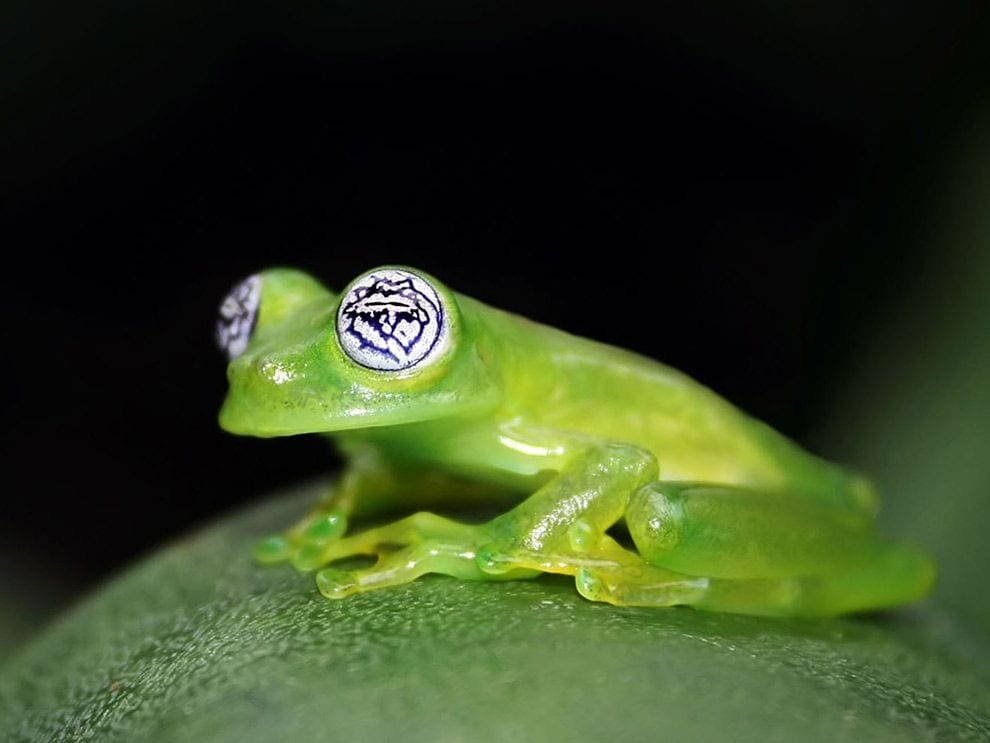
Glass Frog Facts
1) They enjoy tropical climates
They have been seen living in rainforests and areas with tropical climates. They will always have a preference for living above the water while in treetops. This would usually entail that they have a wonderful view of home all to themselves.
There are an estimated 60 different types of Glass Frogs, and a lot more are discovered as time passes by.
2) They are very difficult to spot
Their bright green to olive green color that blends so well with their natural environment is the main reason why they are very difficult to locate in the wild. Scientists believe that their color helps keep them safe by not allowing predators to easily spot them.
3) They are carnivores
They love eating meat, and they can be seen munching on spiders and other insects. Their excellent eyesight gives them an advantage to easily spot prey.
4) They live long
They will normally live 10-14 years, and this is pretty much a lot of time for animals who live in the wild.
5) They are nocturnal
Glass Frogs will prefer to come out at night while the rest of the world is sleeping.
6) They are territorial animals
They are known for making sounds to prevent other animals from entering their territory. There will be instances that they use force to keep these animals away from their territory.
7) Male Glass Frogs have an important role in parental care
The males make sure that the eggs are safe from insects and parasites that might prey on the eggs.
8) You can see their internal organs
You look at them from the bottom part of their body; you can see the liver, heart, and intestines. Their bones can either be green or white.
9) They are confused with the Tree Frogs
You can easily determine if the frog is a Glass Frog by looking at the forward-facing frog. The Tree Frogs’ eyes are located at the sides of their heads.
FAQ Section
How do Glass Frogs adapt to their environment?
Their adaptations have helped them to survive in the wild, and one good feature of this is that their camouflage. They’re like glass that you can easily see-through, and they blend so well with the leaves in the environment.
How does Glass Frog breathe?
This amazing frog species not only has the capability of breathing through their mouths and lungs, but they can also breathe through their skin. However, in order to breathe through their skin, it needs to be kept moist at all times.
What is the life cycle of a Glass Frog?
This will begin by the Glass Frog laying its eggs on the bottom part of the leaves so that the predators will not see them. The eggs will hatch, and the tadpoles will drop right into the water. It usually takes around 12-14 weeks for the tadpoles to becomes fully grown Glass Frogs.
What animals eat Glass Frogs?
Their usual predators would be birds and snakes. However, the chances of them getting eaten by a predator are very slim since they are very difficult to spot in the wild. They have mastered the art of blending well into their environment.
What should I do if my Glass Frog escapes?
The first thing that you should do is inspect the cage and find out how the frog managed to escape. You should search the room where you place the enclosure; you can look for it in dark or moist areas since this might be the place that makes it feel safe. Once you spot the Glass Frog, move slowly so you will not startle it, pick it up gently using your hand, and safely return it back to its tank.

